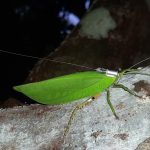
Crickets produce sounds by rubbing a specialised structure called ‘plectrum’ on the margin of one forewing against a file of ‘pegs’ on the other. These sounds get amplified by a resonant structure on the wing called the harp.
A new approach has now been used to predict the acoustic features of calls of different cricket species, in a study led by Rohini Balakrishnan from the Centre for Ecological Sciences, and Vamsy Godthi and Rudra Pratap from the Centre for Nano Science and Engineering. The team used a numerical technique called finite element modeling to study the complex geometry of cricket wings. Focusing on the harp’s geometry, and using the cricket Gryllus bimaculatus as the baseline, they successfully predicted the call frequencies of eight other field cricket species.
The ratio of harp thickness to area emerged as an accurate predictor of call frequency. The call frequencies of all cricket species are all tonal and lie between 2-9 kHz, in spite of 200 million years of evolution.
Such models can be used on museum specimens to predict the call frequencies of cricket species that have not been recorded in the wild. The approach can be extended to study the sounds of other animals and insects as well.






